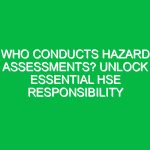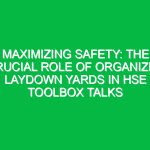Introduction
In the realm of Health, Safety, and Environment (HSE), workplace hazards are critical factors that can significantly impact the well-being of employees, the efficiency of operations, and the integrity of the environment. A workplace hazard refers to any source of potential damage, harm, or adverse health effects on individuals in a working environment. Understanding these hazards is essential for establishing a robust safety culture and ensuring compliance with regulations. Ignoring workplace hazards can lead to severe consequences, including injuries, fatalities, and legal repercussions.
In this article, we will delve deeply into the various types of workplace hazards, explore their implications, and discuss best practices for mitigation. By unlocking the intricacies of workplace hazards, we aim to foster a secure environment where employees can thrive safely and efficiently.
Types of Workplace Hazards
Workplace hazards can be categorized into several types, each requiring specific strategies for identification and management. Understanding these categories is paramount for creating a comprehensive safety plan.
1. Physical Hazards
Physical hazards are among the most common types of workplace hazards. They can stem from the environment or the nature of the work being performed. Examples include:
- Slips, Trips, and Falls: Wet floors, uneven surfaces, and cluttered walkways can lead to accidents.
- Noise: Excessive noise levels can cause hearing loss and communication issues.
- Temperature Extremes: Working in either extreme heat or cold can result in heat stress or hypothermia.
For example, in a manufacturing plant, I once witnessed a near-miss incident where a worker almost fell due to a spill that had not been cleaned up promptly. This incident underscored the importance of maintaining a clean workspace to prevent physical hazards.
2. Chemical Hazards
Chemical hazards arise from the presence of harmful substances in the workplace. They can manifest in various forms, such as gases, vapors, liquids, or solids. Common examples include:
- Exposure to Toxic Chemicals: Chemicals such as benzene or formaldehyde can cause long-term health issues.
- Flammable Materials: Substances that can ignite easily pose significant fire risks.
- Corrosives: Acids and alkalis can cause severe skin burns and respiratory issues.
A case study from a chemical manufacturing company revealed that proper labeling and storage of hazardous materials reduced chemical spills by 30%. This highlights the importance of implementing effective safety protocols.
3. Biological Hazards
Biological hazards are agents that can cause illness or disease. These include bacteria, viruses, fungi, and other microorganisms. In workplaces like hospitals and laboratories, the risk of exposure can be particularly high. Examples include:
- Infectious Diseases: Employees may be at risk of infections, especially in health care settings.
- Mold and Fungi: Poor ventilation can lead to mold growth, which can affect respiratory health.
In a healthcare setting I observed, staff adherence to strict hygiene protocols significantly reduced the transmission of infections among patients and staff. This demonstrated the effectiveness of preventative measures in managing biological hazards.
4. Ergonomic Hazards
Ergonomic hazards occur when the design of a workplace or job does not fit the physical needs of the worker. Overexertion and repetitive strain injuries are common issues associated with ergonomic hazards. Examples include:
- Poorly Designed Workstations: Desks that are too high or low can lead to musculoskeletal disorders.
- Repetitive Motions: Tasks requiring repetitive movements can cause chronic injuries.
For instance, a tech company implemented ergonomic assessments for its employees, resulting in a noticeable decrease in reported back pain. This case emphasizes the value of ergonomic interventions in enhancing employee comfort and productivity.
5. Psychosocial Hazards
Psychosocial hazards are related to the emotional and mental well-being of employees. Factors such as workplace stress, harassment, and work-life imbalance can lead to various psychological issues. Key components include:
- Workplace Bullying: Harassment or intimidation can severely affect morale and mental health.
- High-Pressure Work Environments: Excessive workloads can lead to burnout and anxiety.
A notable example comes from a corporate office where management introduced wellness programs to address stress-related concerns. The result was a significant improvement in employee satisfaction and productivity, highlighting the importance of mental well-being in the workplace.
Identifying and Assessing Workplace Hazards
Identifying workplace hazards is the first step toward effective risk management. Employers must conduct thorough assessments to recognize potential hazards in their environments. This process typically involves:
- Workplace Inspections: Regular inspections help in spotting hazards early on.
- Employee Input: Engaging employees in the hazard identification process can provide valuable insights.
- Reviewing Incident Reports: Analyzing past incidents can help identify recurring hazards.
Once hazards are identified, assessing the level of risk associated with each hazard is crucial. This involves evaluating the potential severity of harm and the likelihood of occurrence. A risk matrix can be a helpful tool in this assessment.
Regulations and Standards
Adhering to regulations and standards is vital in managing workplace hazards effectively. In many countries, regulatory bodies set guidelines that employers must follow. In the United States, the Occupational Safety and Health Administration (OSHA) plays a key role in enforcing safety standards. Key regulations include:
- Hazard Communication Standard (HCS): Requires employers to inform employees about chemical hazards in the workplace.
- Personal Protective Equipment (PPE) Standards: Mandates the provision of appropriate PPE to employees based on the hazards they face.
- General Duty Clause: Requires employers to provide a workplace free from recognized hazards.
Compliance with these regulations not only protects employees but also shields organizations from potential lawsuits and fines. Regular training and updates on these regulations are essential to maintain a safe working environment.
Best Practices for Mitigating Workplace Hazards
Employers can implement several best practices to mitigate workplace hazards effectively:
- Training and Education: Regular training ensures that employees are aware of hazards and know how to respond.
- Personal Protective Equipment: Providing appropriate PPE is essential for protecting employees from specific hazards.
- Emergency Preparedness: Developing and practicing emergency response plans can minimize injury during incidents.
- Encouraging Reporting: Creating an environment where employees feel comfortable reporting hazards can lead to proactive management.
In a construction company I worked with, the implementation of weekly safety meetings led to increased hazard awareness among workers. This proactive approach significantly reduced workplace incidents over time.
Conclusion
Understanding workplace hazards is a fundamental aspect of promoting health, safety, and environmental sustainability. By recognizing the different types of hazards, conducting thorough assessments, adhering to regulations, and implementing best practices, organizations can create a safe working environment for their employees. A commitment to safety not only protects individuals but also enhances productivity and employee morale.
As we move forward, it is essential for both employers and employees to remain vigilant about workplace hazards. Continuous improvement and adaptation to emerging risks will ensure a safer, more secure environment for all. Let us work together to keep our workplaces safe and healthy.


